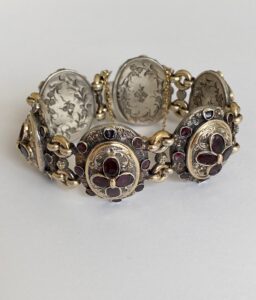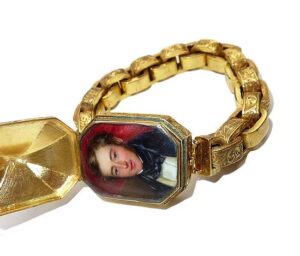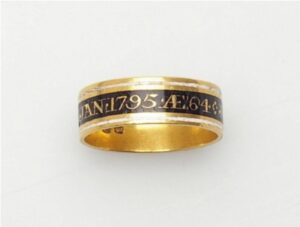
The Georgian Period (1700-1830)
The Georgian period was so named after the four King Georges who ruled in succession throughout this period. It was a prosperous and revolutionary time, particularly in politics, art and architecture, with many technological advancements happening at this time. There were huge developments in science and of course exploration. There was also a changing role for women in society. This all provided a great backdrop for developments in jewellery of the time.
It wasn’t just in Britain, where things were developing at pace and with politics running wild. For example, in America, George Washington was President, and it was a period marked by a Revolution. In France, Louis XVI and Marie Antoinette were at the helm during the French Revolution and Napoleon. In Russia, Catherine the Great reigned.
For Georgian jewellery history, the period spanned from 1714 to 1830 and encompassed the reign of George I, George II, George III and George IV.
During the Georgian period, intricate metal work depicting natural themes came into fashion. This is called repoussé (an example of a repoussé bracelet is shown below). In addition, the use of faceted gemstones became all the rage.
Motifs and Symbolism in Georgian Jewellery
Flowers, butterflies, ribbons, and scrolls were popular motifs in Georgian jewellery. Sentimental jewellery like the ‘lover’s eye’ and also mourning jewellery was popular at this time. One of our favourites, acrostic jewellery (taking the first letter from popular gemstones to make a word, like regard, love, dearest) was also popular.
Gem Cutting Styles in Georgian Jewellery
Table cuts, rose cuts, and old mine cuts were the cuts of the day. Table cuts are not often seen on the market and have both a flat top and bottom and are either square or rectangular. Rose cuts have a flat bottom with a domed faceted top (fairly large facets, not always even). Old mine cuts are the most similar to today’s brilliant cut.


Popular Gemstones and Settings in Georgian Jewellery
The most popular ring stone in Georgian jewellery was the diamond, which was used almost exclusively up until 1750. Diamonds and white paste were more usually set in silver, or silver over 18ct or higher gold.
Garnets, emeralds, topaz and amber were also used. Georgian jewellery was mainly hand crafted and gems were often set in closed settings with foil backing for enhancement. The crimped collet setting as seen in the picture of the rose cut cluster ring from Lang Antiques was very popular at the time. Open settings had not become common during this period.
Paste (different types of cut glass, often coloured) was extremely popular in the 18th Century, as was enamel work.
Metals Used in Georgian Jewellery
Silver over 18 carat gold was often used to highlight colourless gems, e.g. diamonds and clear paste. High carat gold was the order of the day especially 18 carat or 22 carat yellow gold. Instead of lower carat golds, pinchbeck (83% copper and 17% zinc) was used to give the appearance of gold.
Jewellery was often not hallmarked in the Georgian period as it was not a legal requirement to do so.


Rarity and Resources for Georgian Jewellery
Rings from the Georgian Period are now exceedingly rare and there are many forgeries on the market, so special attention must be paid to the style and quality of the ring.
We don’t carry many Georgian pieces at Anadej; however, we would be delighted to help you search if you were after a special piece or suggest other antique jewellery specialists.
We can recommend Antique Animal Jewelry as they are Georgian Jewellery experts and carry a significant and incredible collection and have fascinating blogs on the subject.
A wonderful book full of fantastic information on Georgian Jewellery is: Georgian Jewellery: 1714-1830 by Ginny Redington and Olivia Collings.
